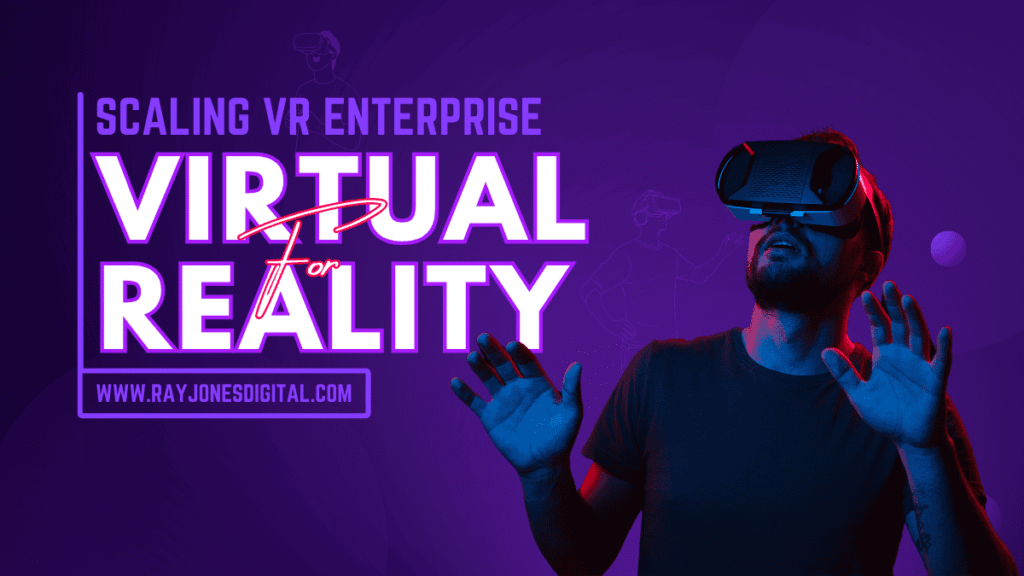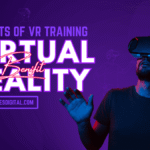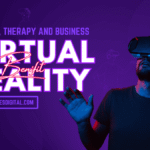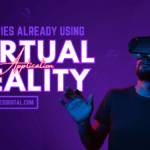
Virtual reality has moved beyond gaming and entertainment to become a transformative force in enterprise operations. Companies across industries are discovering that VR technology offers unprecedented opportunities to enhance training, improve collaboration, and drive innovation at scale. This comprehensive guide explores how organisations can successfully implement and scale VR solutions to achieve measurable business outcomes.
The transition from pilot programmes to enterprise-wide VR deployment requires careful planning, strategic investment, and a deep understanding of both technological capabilities and business requirements. As VR hardware becomes more affordable and software solutions mature, the question is no longer whether enterprises should adopt VR, but how to implement it effectively across their organisations.
Understanding Enterprise VR Applications
Enterprise VR applications span numerous business functions, each offering unique value propositions that can transform traditional workflows and processes. Training and development programmes benefit significantly from VR’s ability to create risk-free environments where employees can practice complex procedures, operate expensive equipment, and develop skills through immersive experiences.
Manufacturing companies utilise VR for equipment maintenance training, allowing technicians to practice on virtual machinery before working with actual systems. This approach reduces downtime, minimises safety risks, and ensures consistent training quality across global operations. Automotive manufacturers have reported 40% faster training completion rates when using VR compared to traditional methods.
Healthcare organisations implement VR for surgical training, patient education, and therapy applications. Medical professionals can practice procedures repeatedly in virtual environments, whilst patients gain better understanding of their conditions through immersive visualisations. These applications demonstrate VR’s potential to improve outcomes whilst reducing costs.
Architecture and construction firms leverage VR for design visualisation, client presentations, and project planning. Stakeholders can walk through virtual buildings before construction begins, identifying potential issues and making informed decisions that prevent costly changes during the building process.
Building Your VR Infrastructure
Successful VR scaling requires robust technical infrastructure that can support multiple users simultaneously whilst maintaining high performance and reliability. Network requirements are particularly critical, as VR applications demand low latency and high bandwidth to deliver smooth experiences.
Hardware considerations extend beyond headsets to include powerful computers, graphics processing units, and storage solutions. Organisations must balance performance requirements with budget constraints, considering both current needs and future scalability. Cloud-based VR solutions are emerging as viable alternatives that reduce hardware requirements whilst providing access to high-quality experiences.
Content management systems become essential as VR libraries grow. Organisations need platforms that can store, organise, and distribute VR content efficiently across their networks. Version control, user permissions, and usage analytics are crucial features that support enterprise-level deployment.
Integration with existing enterprise systems ensures VR solutions complement rather than complicate current workflows. Learning management systems, customer relationship management platforms, and business intelligence tools should seamlessly connect with VR applications to maximise value and adoption.
Developing Compelling VR Content
Content creation represents one of the most significant challenges in scaling VR for enterprise applications. High-quality VR experiences require specialised skills, significant time investment, and substantial resources that many organisations lack internally.
Custom content development allows organisations to create VR experiences tailored to their specific needs and requirements. This approach ensures maximum relevance and effectiveness but requires significant investment in development teams or external partners. Companies should carefully evaluate whether custom development provides sufficient return on investment compared to off-the-shelf solutions.
Third-party content libraries offer cost-effective alternatives for common training scenarios and industry-standard procedures. Many VR software vendors provide extensive libraries of pre-built content that can be customised for specific organisational needs. This approach reduces development time and costs whilst providing proven training materials.
Hybrid approaches combine custom development with existing content libraries, allowing organisations to create unique experiences whilst leveraging proven components. This strategy often provides the best balance of customisation and cost-effectiveness for enterprise implementations.
Content authoring tools are becoming increasingly sophisticated, enabling subject matter experts to create VR experiences without extensive technical knowledge. These platforms democratise content creation, allowing organisations to develop and maintain VR libraries more efficiently.
Training and Change Management
Employee adoption represents a critical success factor in VR scaling initiatives. Many workers may be unfamiliar with VR technology or hesitant to embrace new learning methods. Comprehensive training programmes and change management strategies are essential for successful implementation.
Basic VR literacy training should introduce employees to VR concepts, hardware operation, and safety procedures. This foundation ensures all users can effectively utilise VR systems whilst minimising technical support requirements. Training should address common concerns about motion sickness, eye strain, and technology anxiety.
Champion programmes identify and develop internal VR advocates who can support adoption across different departments and locations. These champions provide peer support, troubleshoot basic issues, and gather feedback to improve VR programmes. Their endorsement often carries more weight than management directives.
Gradual rollout strategies allow organisations to refine their VR programmes based on early feedback whilst building momentum for broader adoption. Starting with enthusiastic early adopters creates positive experiences that encourage wider acceptance throughout the organisation.
Ongoing support systems ensure users can access help when needed and continue developing their VR skills over time. Help desks, user communities, and regular training updates maintain engagement and proficiency as VR programmes expand.
Measuring ROI and Business Impact
Demonstrating clear return on investment is crucial for securing ongoing support and funding for VR initiatives. Organisations must establish baseline metrics before implementation and track improvements across relevant business indicators.
Training effectiveness metrics include completion rates, skill assessment scores, and knowledge retention measurements. VR training often shows superior results compared to traditional methods, with studies indicating 75% retention rates for VR-trained employees versus 10% for lecture-based training after one year.
Operational efficiency improvements can be measured through reduced training time, decreased error rates, and improved safety records. Manufacturing companies report 30% reduction in training time and 50% fewer safety incidents after implementing VR training programmes.
Cost savings calculations should include reduced travel expenses, decreased equipment wear, and minimised materials consumption. Virtual training eliminates many traditional training costs whilst providing consistent experiences across global operations.
Employee satisfaction and engagement metrics help assess the broader impact of VR implementation on workforce morale and retention. Many organisations report increased employee satisfaction and reduced turnover rates following VR programme launches.
Addressing Implementation Challenges
Technical challenges often arise during VR scaling initiatives, requiring proactive planning and problem-solving capabilities. Performance issues, compatibility problems, and user experience inconsistencies can undermine adoption and effectiveness.
Hardware standardisation helps ensure consistent experiences across different locations and user groups. Organisations should carefully select VR hardware that meets their performance requirements whilst providing reliable support and upgrade paths.
Software compatibility testing prevents integration issues that can disrupt business operations. VR applications should undergo thorough testing with existing enterprise systems before deployment to identify and resolve potential conflicts.
User experience optimisation ensures VR applications meet enterprise usability standards. Complex interfaces, lengthy loading times, and unintuitive controls can frustrate users and reduce adoption rates. Regular user feedback and iterative improvements are essential for maintaining positive experiences.
Scalability planning addresses how VR systems will perform as usage increases and new applications are added. Infrastructure must be designed to accommodate growth without compromising performance or reliability.
Security and Compliance Considerations
Enterprise VR implementations must address security and compliance requirements that may not apply to consumer applications. Data protection, user privacy, and regulatory compliance are crucial considerations that can impact VR system design and deployment.
Data encryption protects sensitive information transmitted between VR applications and enterprise systems. Training records, user behaviour data, and proprietary content require appropriate security measures to prevent unauthorised access or disclosure.
User authentication systems ensure only authorised personnel can access VR applications and content. Integration with existing identity management systems provides seamless user experiences whilst maintaining security standards.
Compliance requirements vary by industry and jurisdiction, affecting how VR systems collect, store, and process user data. Healthcare organisations must consider HIPAA requirements, whilst financial services companies must address relevant banking regulations.
Regular security audits and updates maintain protection against evolving threats and ensure ongoing compliance with changing regulations. VR systems should be included in broader enterprise security programmes and policies.
Future-Proofing Your VR Investment
Technology evolution in VR continues at a rapid pace, with new hardware, software, and capabilities emerging regularly. Organisations must plan for technological changes whilst protecting their investments in current systems.
Modular architecture designs allow organisations to upgrade individual components without replacing entire VR systems. This approach reduces long-term costs whilst enabling adoption of new technologies as they become available.
Vendor partnerships provide access to ongoing support, updates, and new features that enhance VR capabilities over time. Strong relationships with VR technology providers help organisations stay current with industry developments and best practices.
Standards adoption ensures VR investments remain compatible with future technologies and industry developments. Open standards and interoperable solutions provide more flexibility than proprietary systems that may become obsolete.
Continuous evaluation processes help organisations assess their VR programmes’ effectiveness and identify opportunities for improvement or expansion. Regular reviews ensure VR initiatives continue delivering value as business needs evolve.
Transforming Enterprise Operations Through VR
Virtual reality represents a fundamental shift in how enterprises approach training, collaboration, and innovation. Organisations that successfully scale VR implementation gain significant competitive advantages through improved efficiency, enhanced employee capabilities, and new business opportunities.
The key to successful VR scaling lies in treating it as a strategic business initiative rather than a technology project. This approach requires executive support, cross-functional collaboration, and long-term commitment to realising VR’s full potential.
As VR technology continues maturing and costs decrease, enterprise adoption will accelerate. Organisations that begin scaling VR now will be better positioned to leverage future innovations and maintain competitive advantages in their respective markets.
Start your VR scaling journey by identifying specific business challenges that VR can address, building internal support for implementation, and partnering with experienced VR technology providers who understand enterprise requirements.

I am Ray Jones Digital
My current occupations: a Digital Marketer, Local SEO expert, Link Builder, and WordPress SEO specialist. Shopify SEO, Ecommerce Store Management, and HTML & WordPress Developer I have been practicing the above mentioned services for more than 10 years now As an SEO expert working with your ongoing projects.



